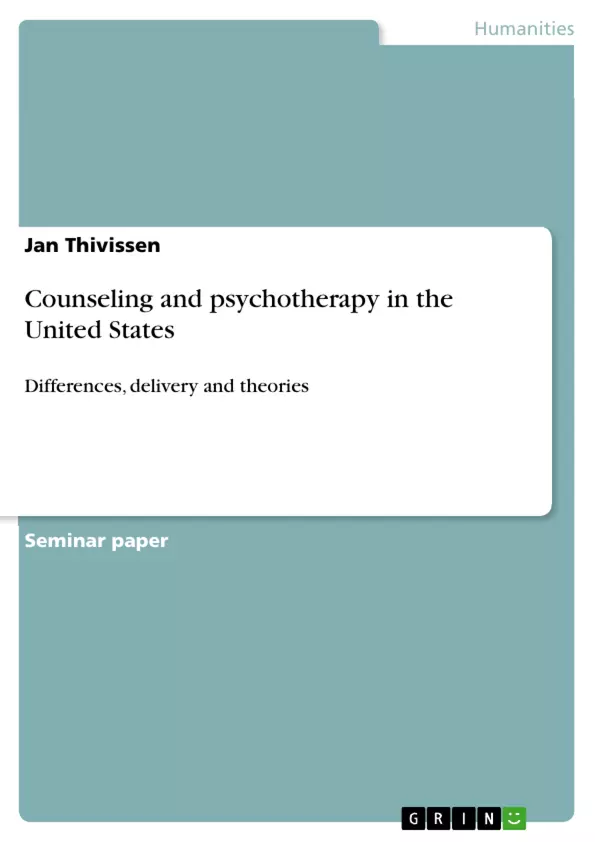Abstract
This paper discusses differences and similarities among counseling and psychotherapy in the United States. The author describes both professions, their historical roots, definitions, theories, their associations, and services delivery. The description enables the author to draw comparisons with the German-speaking system. It has been found that principally no reasonable distinction between the professions in the United States can be stated. Scholars, practitioners, and consumers are using the terms interchangeably. Further findings indicate a great number of professional stakeholders (associations, their subdivisions and specializations, professions like psychology, social work, or education), what carries advantages and disadvantages for the mental health profession. Based on the findings the author suggests further questions on how different mental health systems might benefit from each other.
Inhaltsverzeichnis (Table of Contents)
- Abstract
- Preface
- Table of Contents
- Introduction
- Standard in Germany
- Counseling in the U.S.
- Principal Definition
- Education Pathways
- Historical Development
- Primary Theories
- Cognitive-behavioral counseling
- Humanistic theories of counseling
- Existential counseling
- Adlerian counseling theory and practice
- Systems theory
- National Association
- Service Delivery
- Psychotherapy in the U.S.
- Principal Definition
- Education Pathways
- Historical Development
- Primary Theories
- Psychodynamic psychotherapy
- Cognitive-behavioral psychotherapy
- Humanistic-experiential psychotherapy
- Psychotherapy integration (eclecticism)
- National Associations
- Service Delivery
- Counseling and Psychotherapy in the U.S.
- Differences and similarities between counseling and psychotherapy
- Principal definitions
- Education pathways
- Historical developments
- Primary Theories
- National Associations
- Service Delivery
- Conclusion
- Comparison to Germany
- Ideas for Future Studies
- References
Zielsetzung und Themenschwerpunkte (Objectives and Key Themes)
The main objective of this paper is to compare and contrast the fields of counseling and psychotherapy in the United States with the German-speaking system. The author aims to identify similarities and differences in definitions, education pathways, historical development, key theories, national associations, and service delivery models. Through this comparative analysis, the author seeks to gain insights into the strengths and weaknesses of both systems and to develop a deeper understanding of the complexities of mental health services.
- The definition and scope of counseling and psychotherapy in the United States.
- The historical development and evolution of these fields.
- The key theories and theoretical frameworks used in counseling and psychotherapy.
- The role of national associations and professional organizations in shaping the field.
- The various models of service delivery utilized in both counseling and psychotherapy.
Zusammenfassung der Kapitel (Chapter Summaries)
This paper begins with an introduction that sets the stage for the comparative analysis, outlining the author’s motivation for undertaking this study. It then delves into the "Standard in Germany," providing a brief overview of the German mental health system. Following this, the paper focuses on counseling in the United States, exploring its principal definition, education pathways, historical development, and key theories such as cognitive-behavioral counseling, humanistic theories, existential counseling, Adlerian theory, and systems theory. The chapter also examines the role of the National Association and the delivery of counseling services. Next, the paper examines psychotherapy in the United States, following a similar structure as the counseling chapter. This section explores various theoretical perspectives, including psychodynamic psychotherapy, cognitive-behavioral psychotherapy, humanistic-experiential psychotherapy, and psychotherapy integration (eclecticism). The chapter also explores the role of national associations and the delivery of psychotherapy services.
Finally, the paper explores the differences and similarities between counseling and psychotherapy in the United States, comparing their definitions, education pathways, historical developments, key theories, national associations, and service delivery models.
Schlüsselwörter (Keywords)
This paper focuses on the fields of counseling and psychotherapy in the United States, comparing them to the German-speaking system. It examines key concepts such as definitions, education, historical development, theoretical frameworks, national associations, and service delivery models. The paper delves into specific theories, such as cognitive-behavioral counseling, humanistic theories, existential counseling, Adlerian theory, psychodynamic psychotherapy, cognitive-behavioral psychotherapy, humanistic-experiential psychotherapy, and psychotherapy integration (eclecticism). The paper also considers the impact of professional organizations and their role in shaping the field.
- Quote paper
- Dipl. Sozialarbeiter/Sozialpädagoge; Master of Science in Social Work Jan Thivissen (Author), 2006, Counseling and psychotherapy in the United States, Munich, GRIN Verlag, https://www.grin.com/document/78657



